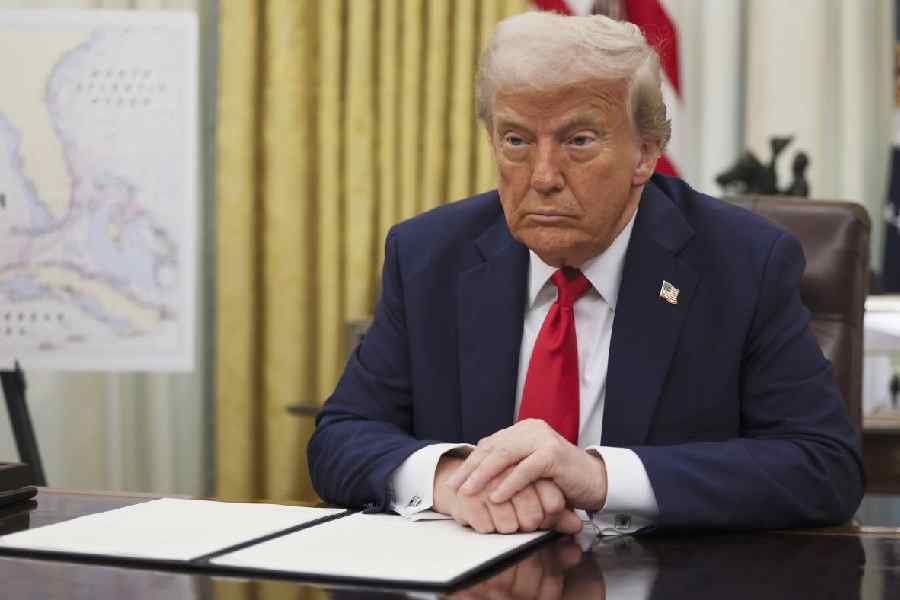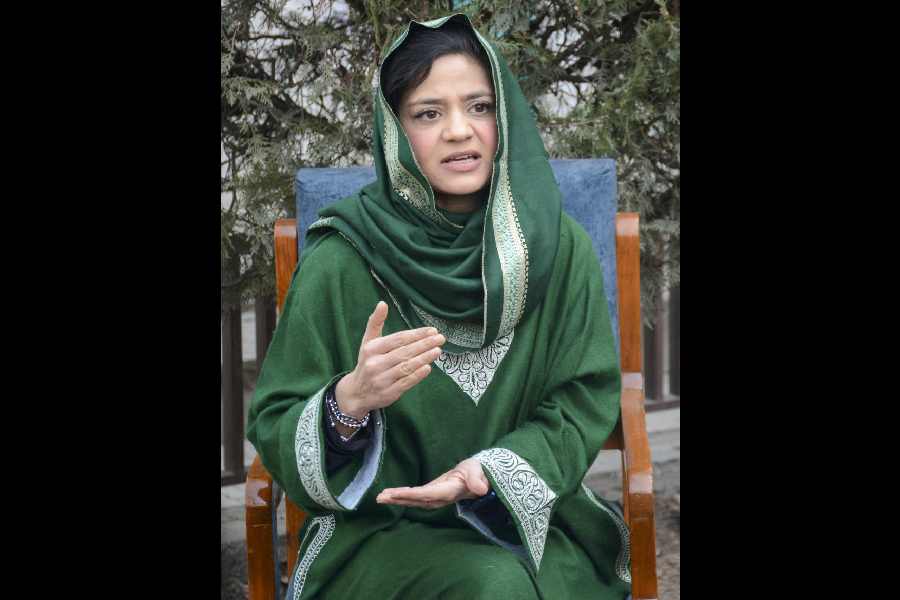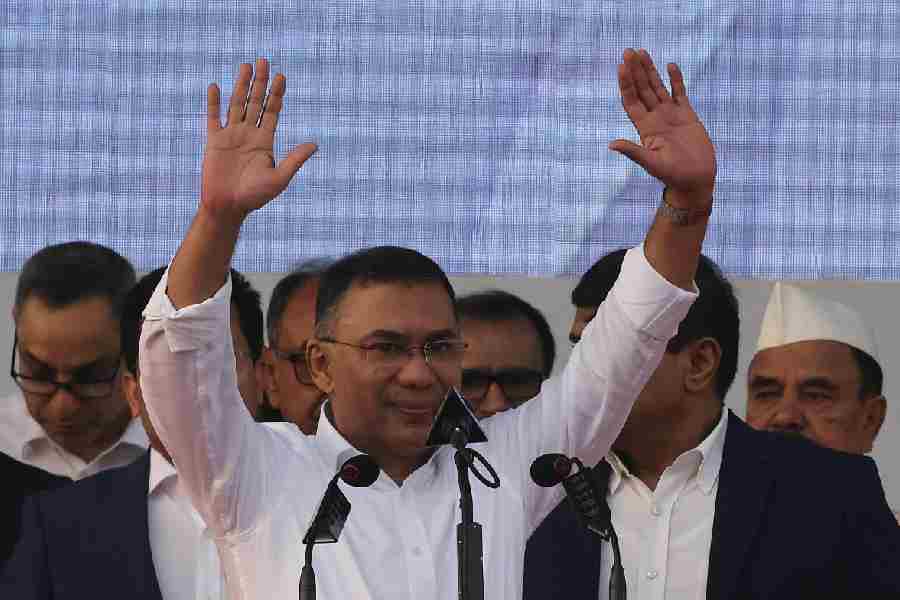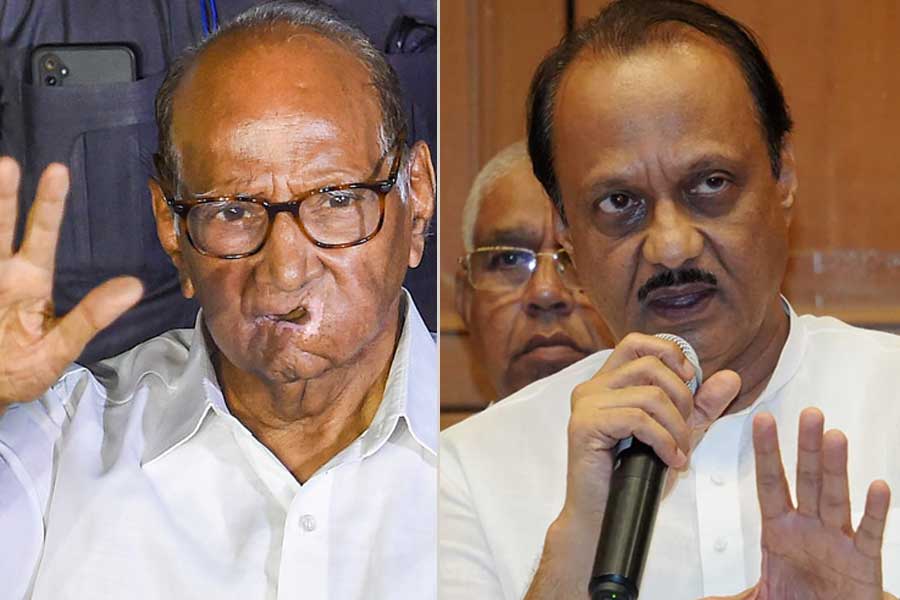Tariff, the most “beautiful word” in the dictionary of US President Donald Trump, robbed Indian investors of ₹1.25 lakh crore on Tuesday as uncertainties over his sweeping reciprocal taxes cast a shadow on Dalal Street and benchmark indices Sensex and Nifty tanked.
“To me, the most beautiful word in the dictionary is ‘tariff’,” Trump had said repeatedly on his campaign trail in 2024. His words and actions since his return to the White House for the second term have only refurbished the image of “a Tariff Man” that he sought to project in a social media post in 2018.
A Bloomberg report said that Trump is likely to make announcements on his tariff proposals at the Rose Garden of the White House at 3pm Washington time on Wednesday — 12.30pm IST on Thursday. Trump has dubbed April 2 “Libertation Day”.
Amid confusion on what Trump will unveil, The Washington Post reported that White House aides have drafted plans for 20 per cent tariffs on most goods imported to the US. It added that Trump’s aides are considering a plan that would raise duties on products by about 20 per cent from nearly every country rather than the more targeted approaches that have also been considered.
The report, however, quoted a White House aide as saying that any report ahead of Wednesday’s event is “mere speculation”.
Ahead of the much-awaited announcement, the Indian equities market convulsed and the total market capitalisation of all BSE-listed companies fell by ₹1.25 lakh crore to ₹411.62 lakh crore (See page 6).
‘Nicer’ numbers
Amid weakening market sentiments across the globe, Trump said on Monday that the tariffs he was preparing to announce on Wednesday would be “nicer” than the trade policies of US trading partners.
“We are going to be very nice by comparison to what they were. The numbers will be lower than what they have been charging us, and in some cases, maybe substantially lower,” Trump told reporters at the Oval Office.
“Relatively speaking, we’re going to be very kind,” he went on, adding to the confusion on what’s in store for the world economy.
Later in the day, the US President made a specific claim about India — a country helmed by his “friend” Narendra Modi — and said that New Delhi is set to drop its tariffs on American products “substantially”.
“If you look at the European Union on cars... the EU has already dropped their tariffs down to 2.5 per cent... which was announced two days ago.... I heard a little while ago that India is going to be dropping its tariffs very substantially...,” the US President told reporters at the Oval Office.
Delhi dilemma
There was, however, no official reaction from New Delhi, which is working on a bilateral trade agreement to promote two-way India-US commerce and investments, on the claim of a substantial reduction in tariff.
The commerce ministry is working on different scenarios to assess the possible fallout of reciprocal tariffs to be imposed by the US administration on April 2 on its key trading partners, including India, PTI reported, quoting sources.
The domestic industry and exporters have raised concerns over the possible impact of the US’s reciprocal tariffs on India’s exports as the duties could make the goods uncompetitive in the global markets. The US is the largest trading partner of India.
Sources said that as the impact of these tariffs may vary from sector to sector, the ministry is busy preparing different scenarios. These scenarios would be important to help domestic companies deal with the duties as the scale and scope of the tariffs is still shrouded in mystery.
According to Delhi-based think tank GTRI, the major sectors likely to be hit by reciprocal tariffs include agriculture, meat and processed food, automobiles and auto components, gems and jewellery, chemicals and pharmaceuticals, electrical, telecom and electronic products, iron and steel products, textile and clothing.
Analysts expect the impact on India from reciprocal tariffs could be between 0.1 per cent and 0.16 per cent of GDP.
“There is no clarity on whether the reciprocal tariff, if imposed, will be at the weighted average rate on all imports or whether sector/item-wise tariffs will be studied and imposed. Trump’s yo-yoing on tariffs over the past month has added significant uncertainty globally,” said Madhavi Arora, chief economist at Emkay Global.
Dear duty
According to the US Trade Representative’s National Trade Estimate Report 2025, India maintains “high” import duties on a wide range of American goods such as agricultural items, drug formulations and alcoholic beverages, besides imposing non-tariff barriers.
Currently, US goods face a weighted average tariff of 7.7 per cent in India, while Indian exports to the US attract only 2.8 per cent, leading to a 4.9 per cent difference. Indian farm exports to the US currently face a 5.3 per cent duty, whereas US farm exports to India face a much higher 37.7 per cent, creating a 32.4 per cent gap.
Trade experts said that at the broad sector level, the potential tariff gaps between India and the US varied across sectors.
The gap is 8.6 per cent for chemicals and pharmaceuticals, 5.6 per cent for plastics, 1.4 per cent for textiles and clothing, 13.3 per cent for diamonds, gold and jewellery, 2.5 per cent for iron, steel and base metals, 5.3 per cent for machinery and computers, 7.2 per cent for electronics, and 23.1 per cent for automobiles and auto components.
The higher the tariff gap, the worse affected a sector will be, GTRI founder Ajay Srivastava has said.
Taming taxes
The Modi government has been on a charm offensive ever since Trump assumed office in January to soften the blow of the proposed retaliatory tariff.
Days after Trump took oath, the Union budget cut basic customs duties on motorcycle and luxury cars, potentially benefiting US companies such as Harley Davidson and Tesla. Peak import tariff was also lowered to 70 per cent from 150 per cent on a range of items such as solar cells and machinery.
Taking cognisance of the White House’s repeated insinuation about import duty on Bourbon whiskey, India also cut tariff from 150 per cent to 100 per cent, creating more market access for American whiskeys such as Jack Daniel’s and Jim Beam.
Shortly after the budget was presented in Parliament on February 1, Modi travelled to Washington where the leaders agreed to work out a long-awaited bilateral trade agreement as early as September-October. The deal is in progress.
During the visit, Trump said India had agreed to purchase more defence equipment from the US and procure oil and gas. If it materialises, it would certainly close the trade gap between the two countries, which is now in favour of India.
In tandem with the below-the-line approach to create greater market access for US companies, two of India’s top telecom firms made back-to-back announcements to partner Starlink, owned by Trump’s closest confidant and entrepreneur Elon Musk, to bring satellite telephony to India.
Surplus surge
The India-US bilateral trade was $124 billion in 2024. Exports from India to the US reached $81 billion and imports amounted to $44 billion, resulting in a trade surplus of $37 billion for India in 2024.
India’s top exported items to the US are electronics, gems and jewellery, pharma products, machinery for nuclear reactors and refined petroleum products. India’s top imported items from the US are energy commodities such as crude oil, natural gas, pearls/precious stones, machinery, electronics, and aircraft and parts.
India’s goods trade surplus with the US has seen a two-fold increase in the past decade, rising from $19 billion in 2015 to $37 billion in 2024. The surge is primarily attributed to a heightened trade surplus in electronic items after the implementation of a production-linked incentive scheme in 2020. Apart from electronic items, higher exports of pharma and textiles have driven India’s trade surplus with the US over the past decade.










